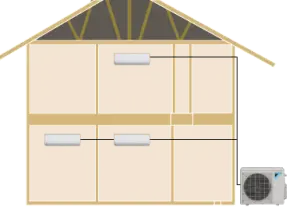What Does HSPF Mean?
If you have recently purchased or thought about purchasing a heat pump, you’ve probably seen the yellow label that tells you what the HSPF is. If you don’t know what HSPF is, it probably looked like a random number on a scale. So, what does HSPF mean?
HSPF stands for Heating Seasonal Performance Factor. In the simplest terms, it’s a way to measure how energy efficient a heat pump is at heating your home. More efficient heat pumps have a higher HSPF.
In this post, we’ll get deeper into what HSPF is, how you calculate it, how it’s changing, and how it can help you save money.
What HSPF Means for You?
Heat pumps offer a variety of benefits. Knowing the HSPF of a heat pump allows you to know the magnitude of those benefits. Whether you want to reduce your carbon footprint or save money on energy, you will want to know how efficient your heat pump is.
Having a heat pump with a higher HSPF means you’ll be using less energy to heat your home. Heat pumps are more efficient than furnaces. That means that having a more efficient heat pump is going to save you even more on energy bills.
It’ll also help you reduce the carbon emissions created from heating your home. If you are concerned with that, then this will be a very important statistic to know.

How do You Know a Heat Pump’s HSPF?
Like with furnaces and AC units, the Department of Energy has requirements for how manufacturers display a heat pump’s power usage. A yellow Energy Star label should be somewhere on the model. If you can’t find it, you can also ask the company that installed it.
The label should show the HSPF on a scale of 8.2 to 13.5.
How do You Calculate HSPF?
Now, we’re going to get more specific. HSPF is the ratio of heating output in BTUs (British Thermal Units) over electricity used in kilowatt-hours. What that means is that you divide the BTUs a heat pump creates during a heating season over the kilowatt hours it uses. The resulting number is the HSPF of the heat pump.
For example, a heat pump with an HSPF of 8 means that it creates 8 BTUs per kilowatt hour.

What are HSPF Standards?
The Department of Energy has created standards to determine what is a good HSPF. Not only do these standards help the US meet its emission goals, but they also help you save money on energy. These standards do change based on the type of heat pump you have.
Department of Energy Minimums
According to the department of energy, 8.2 HSPF is the minimum for an efficient heat pump. That means that only heat pumps with an HSPF of 8.2 or higher are energy star approved. As a consumer, that means you have to have a unit with a rating of 8.2 HSPF to be eligible for a US Energy Tax Credit.
The size of the system might also make it subject to a different minimum. Talk with your HVAC sales pro, so that you know if you’re getting a model that is eligible for a tax credit.
This standard will increase by 2023. Starting in 2023, the minimum HSPF will be 8.8. That is something to keep in mind if you are shopping for a new heat pump. You might benefit more from a heat pump that has a rating of 9 at the very least.
Single vs. Split System Minimums
There are two types of heat pump packages: single or split.

A single system heat pump connects to one head (the indoor unit that's usually attached to your wall) inside your home.

A split system connects to multiple heads.
The minimum HSPF differs based on the type of package you have installed. A single package heat pump has the minimum requirement of 8.2. A split package has a slightly higher minimum of 8.5.
How HSPF Relates to COP?
If you enjoy being as informed as possible about your equipment, then you also need to know about the Coefficient of Performance (COP). The COP is another efficiency metric for HVAC equipment, and it relates to HSPF.
What Is COP?
The COP of a heat pump measures the amount of heat created over the energy used to do so. It’s a practical measurement to see how much energy is used to create a difference in temperature. This gives you a way to measure your energy consumption when you raise a room by one degree.
Like HSPF, heat pumps with a higher COP are more efficient.
How do You Convert HSPF to COP?
Both HSPF and COP are measurements of a heat pump’s energy usage. They are closely related and pretty easy to convert. If you want to find a unit’s COP, simply multiply the HSPF by 0.293.
For an example, take a heat pump with Performance Factor of 9. Multiply 9 by 0.293. Then round to the nearest tenth. So, that unit has a COP of 2.64.
Bottom Line: What You Need to Know
In this post, we went over the basic summary of HSPF, the technical definition, how it’s calculated, and the regulation regarding it. So, what do you need to take away from this?
As much or as little as you like.
If all you care about is saving money on your energy bill, then you just need to know that heat pumps with a higher rating use less energy.
If you want to reduce your carbon emissions, then you might look at the HSPF and the COP to determine how much energy you used to heat your home.
If you love statistics and technology, then you may take all of this information in and start calculating your heat pump’s energy usage.
Who are Advantage Heating and Air Conditioning?
We are your local HVAC Experts out of Salem, Oregon. We hope that this post gave you the information you need to shop for a new heat pump. If you have other questions about HVAC systems, check out our other blogs. To learn more about who we are and how we can help you, visit our website and follow us on social media – we’re here when you need us!
Here are some others services! You can check!







